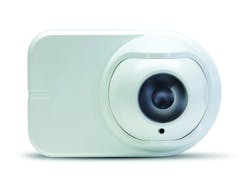Open-area Smoke Imaging Detection (OSID) overcomes the weaknesses of traditional detectors used in large, open spaces where only standard sensitivity detection is required. In its simplest configuration, OSID uses one imager, a camera-like device with a wide field of view, and a wired or battery-powered emitter roughly aligned on the opposite wall within the protected area. The emitter sends both infrared and ultraviolet coded light signals to the imager. If the light reception is altered due to the presence of genuine smoke particles, the imager will go into alarm. The novel use of dual light frequencies in an open path device enables OSID to discriminate between real smoke and other objects, including solid objects, insects, steam and dust, thus drastically reducing false alarms.
